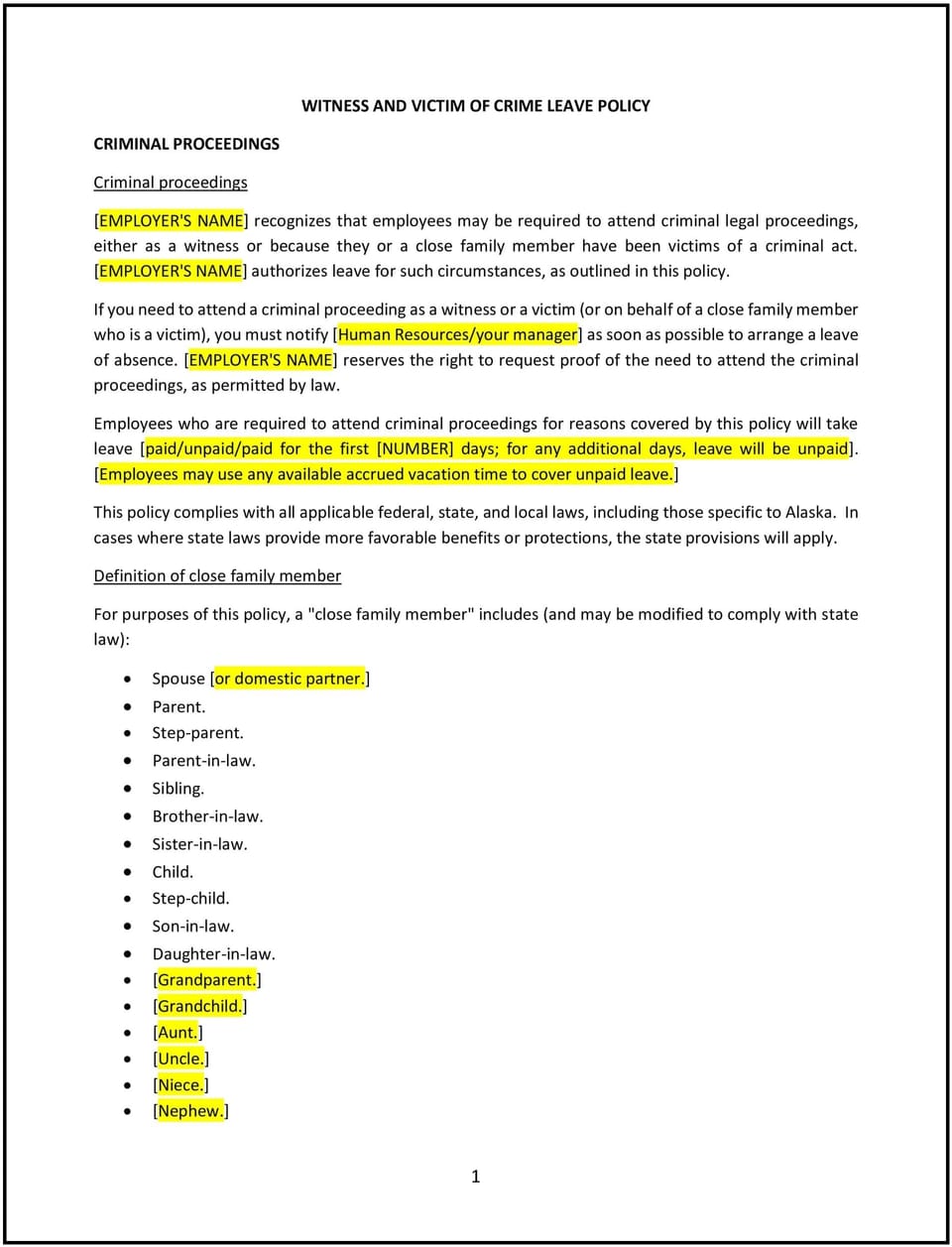Witness and victim of crime leave policy (Alaska): Free template

Witness and victim of crime leave policy (Alaska)
In Alaska, a witness and victim of crime leave policy provides employees with guidelines for taking time off when they are required to appear as a witness or victim in legal proceedings. This policy ensures compliance with state and federal laws while supporting employees during challenging times.
By implementing this policy, businesses can foster a supportive and fair workplace while maintaining operational stability.
How to use this witness and victim of crime leave policy (Alaska)
- Define eligibility: Clearly specify which employees are eligible for leave, such as those subpoenaed as witnesses, victims, or family members of victims.
- Outline leave duration: State how much leave is allowed and whether it is paid, unpaid, or requires the use of accrued paid time off.
- Include request procedures: Provide instructions for employees to notify their manager, submit documentation such as subpoenas or court notices, and request leave in advance whenever possible.
- Address confidentiality: Emphasize that details of the employee’s situation will be handled confidentially to protect their privacy.
- Clarify job protection: Reassure employees that their job will be protected while on leave, in compliance with applicable laws.
Benefits of using a witness and victim of crime leave policy (Alaska)
A witness and victim of crime leave policy offers several advantages for businesses in Alaska. Here’s how it helps:
- Supports compliance: Ensures adherence to state and federal laws protecting employees involved in legal proceedings.
- Demonstrates empathy: Shows employees that the company values their well-being and respects their legal obligations.
- Promotes fairness: Establishes consistent procedures for granting leave to eligible employees.
- Protects privacy: Handles sensitive situations discreetly, fostering trust and confidence among employees.
- Maintains operations: Provides clear guidelines for planning and managing workloads during employee absences.
Tips for using a witness and victim of crime leave policy (Alaska)
- Tailor to state requirements: Align the policy with Alaska’s specific laws regarding witness and victim rights.
- Address operational needs: Develop strategies for redistributing workloads or hiring temporary support during employee absences.
- Educate managers: Train supervisors on handling leave requests sensitively and in compliance with the policy.
- Communicate the policy: Include it in the employee handbook and review it with employees during onboarding or training sessions.
- Update regularly: Revise the policy to reflect changes in legal requirements or company practices.
Q: Who is eligible for leave under this policy?
A: Employees required to serve as witnesses, victims, or family members of victims in legal proceedings are eligible, as specified in the policy.
Q: Is this type of leave paid or unpaid?
A: Leave may be unpaid unless the company provides paid leave as part of its benefits or the employee uses accrued PTO.
Q: What documentation is required to request leave?
A: Employees must submit subpoenas, court notices, or other official documents verifying their need for leave.
Q: How can businesses manage workloads during an employee’s leave?
A: Redistribute tasks among team members or consider temporary staffing solutions to ensure continuity.
Q: How often should this policy be reviewed?
A: Review the policy annually or whenever changes occur in state laws or company operations.
This article contains general legal information and does not contain legal advice. Cobrief is not a law firm or a substitute for an attorney or law firm. The law is complex and changes often. For legal advice, please ask a lawyer.


